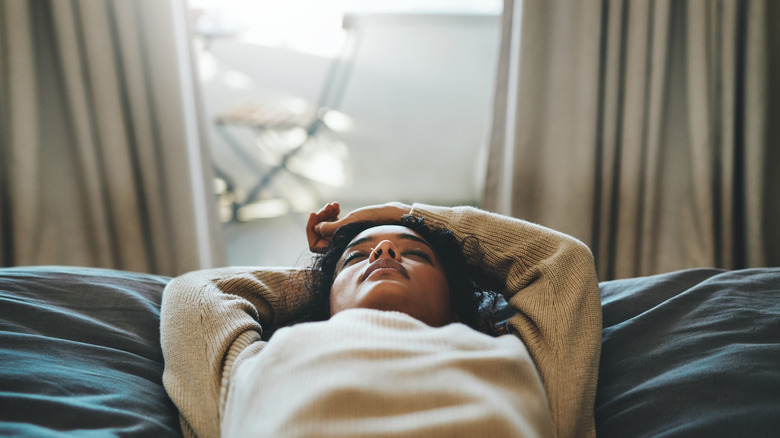TikTok Swears By The Alpha Bridge Sleep Technique For Catching Easy Zs. But Does It Work?
If you're ever counted sheep or closed your eyes shut and willed sleep to come in the middle of the night, to no avail, TikTok might seem like the place to visit next. And who can blame you? From the drunken monkey movement for a better night's sleep to placing a bar of soap under your sheets to drift off to sleep, there are surprisingly creative, quirky, and simple hacks you can try.
None more simple than the hack that seems to be making the rounds now – the alpha bridge sleep technique. Posted by author and psychologist Erica Terblanche, who goes by the handle erica.terblanche on the platform, the video has amassed a large number of views, likes, shares, and comments. The basic idea behind the hack is to close your eyes for a little while and then open them up just a sliver for a few seconds before closing them again, all the while counting to keep time in your head.
Does it work? Well, if my own experience of trying the hack out mid-work (just for the fun of it) speaks for anything, it sure does. Not only did the exercise instantly relax me (thanks to the counting while having my eyes closed), it also made me drowsy. Safe to say, you shouldn't be trying this at work. Read on for more on the alpha bridge sleep technique and why it's effective below.
What is the alpha bridge sleep technique?
According to Erica Terblanche, this hack will even help you fall asleep on an airplane. It doesn't matter if you're sitting in a chair or lying down on a bed — all you need is to be in a comfortable position. Terblanche referred to it as "going over the alpha bridge."
The hack has four steps. You start by making yourself comfortable, wherever you are. On an airplane, this might mean reclining your seat and leaning back with an eye mask; on the bed, this might look like getting under the covers and lying down in a relaxed position. Then "close your eyes and count to 30. Then open your eyes a little sliver, like a little half moon, and count to five," explained the psychologist. You then repeat the 30-minute count with your eyes fully closed, followed by opening them again to a half moon shape and counting to five. "And then close your eyes again and just watch your breathing go in your nose and out of your nose. Into your nose, out of your nose," added Terblanche.
According to the life coach and endurance runner, this sleep hack should put most people to sleep after just the first cycle (kind of like the military sleep method to make you fall asleep in two minutes). The alpha bridge snooze technique seems to gets its name from the fact that it boosts the generation of alpha waves.
What are alpha waves and why are they important for sleep?
As explained by sleep physician, Dr. Brandon Peters (via Sleep Foundation), "Alpha activity is a normal finding during the transition from quiet wakefulness to sleep." Think of your brain as having different levels of activity at different states during the day and night. While gamma waves (greater than 30 Hz) signal alertness and even agitation, and beta waves (13-30 Hz) correspond with an awake state, alpha waves (8-13 Hz) are what occur when you're relaxed or sleepy. By employing the sleep hack, you're using eye movement to influence your brain to shift between beta waves and alpha waves, explained licensed clinical psychologist and director of Sleep Health at Sleepopolis, Dr. Shelby Harris (via Bustle). More simply put, you're inducing sleepiness by doing the physical movements that come with the calm and relaxing alpha waves. Having your eyes closed is one physical stance that corresponds with the generation of alpha waves.
Despite the fact that it did make me drowsy, however, experts warn that the alpha bridge sleep technique might not be effective on everyone, especially those who have chronic insomnia or sleep disorders. Also, it goes without saying that relying on TikTok sleep hacks if you're dealing with sleeplessness every night is not the best idea. While "going over the alpha bridge" is a tool you can turn to occasionally, persistent sleep troubles require a visit with a sleep specialist.

